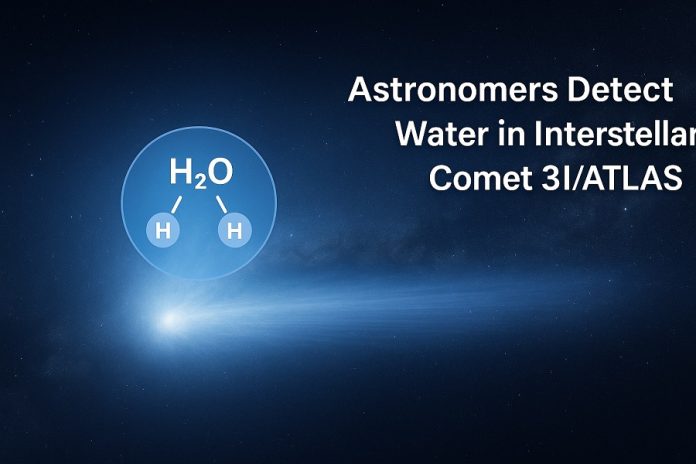
For millions of years, a frozen fragment of ice and dust wandered alone between the stars, like a sealed bottle drifting in a cosmic ocean.
Earlier this year, that “message in a bottle” entered our solar system.
Astronomers named it 3I/ATLAS, only the third interstellar comet ever discovered.
When scientists at Auburn University turned NASA’s Neil Gehrels Swift Observatory toward it, they uncovered a remarkable signal: the first detection of hydroxyl gas (OH) from this visitor—a chemical fingerprint of water.
This breakthrough came thanks to Swift’s ultraviolet telescope. Because Earth’s atmosphere blocks ultraviolet light, ground-based observatories cannot detect these faint signals.
But Swift, orbiting high above Earth, could see the comet’s ghostly ultraviolet glow.
That glow is produced when sunlight breaks apart water molecules, leaving behind OH.
For comet researchers, water is the essential yardstick: it drives a comet’s activity, dictates the release of other gases, and serves as the chemical baseline for comparing comets.
Detecting water in 3I/ATLAS means astronomers can now study this alien visitor using the same framework they apply to comets born in our own solar system.
What makes the discovery even more striking is where the water activity was detected. Swift observed OH when ATLAS was nearly three times farther from the sun than Earth.
At that distance, the surface of a comet is usually too cold for water ice to vaporize directly.
Yet ATLAS was losing water at a rate of about 40 kilograms per second—the equivalent of a fire hose blasting nonstop. Most solar-system comets remain inactive so far from the sun, suggesting something unusual is happening inside ATLAS.
Researchers believe the comet’s nucleus may be releasing tiny icy grains into space. Sunlight could then heat these grains, causing them to release water vapor and feed the surrounding cloud of gas.
Such extended sources of water have been seen in only a handful of distant comets, pointing to complex internal layers of ice that record how the object formed in its original star system.
Each interstellar comet discovered so far has told a different story. ‘Oumuamua, the first, appeared to be dry. The second, 2I/Borisov, was rich in carbon monoxide. Now ATLAS has revealed water in a way that challenges expectations.
Together, these cosmic messengers show that the chemistry of comets—and the conditions of planet formation—vary widely from one star system to another.
Such diversity hints at the many ways planets and possibly life itself could arise in the galaxy.
The technical achievement of the detection is also notable. Swift carries a relatively small 30-centimeter telescope, but in orbit it can see ultraviolet wavelengths invisible from Earth’s surface.
Its sensitivity rivals that of much larger ground-based telescopes for this kind of observation. By targeting ATLAS within weeks of its discovery, the Auburn team captured the crucial ultraviolet signature before the comet faded or moved too close to the sun.
“When we detect water—or even its faint ultraviolet echo—from an interstellar comet, we’re reading a note from another planetary system,” said Dennis Bodewits, professor of physics at Auburn University. “It tells us that the ingredients for life’s chemistry are not unique to our own.”
3I/ATLAS has now faded from view but will reappear after mid-November, offering scientists another chance to follow its journey.
For now, its ultraviolet fingerprint marks the first clear evidence that interstellar comets can carry water across the stars—tying distant planetary systems to our own through one of life’s most essential ingredients.
Source: Auburn University.



